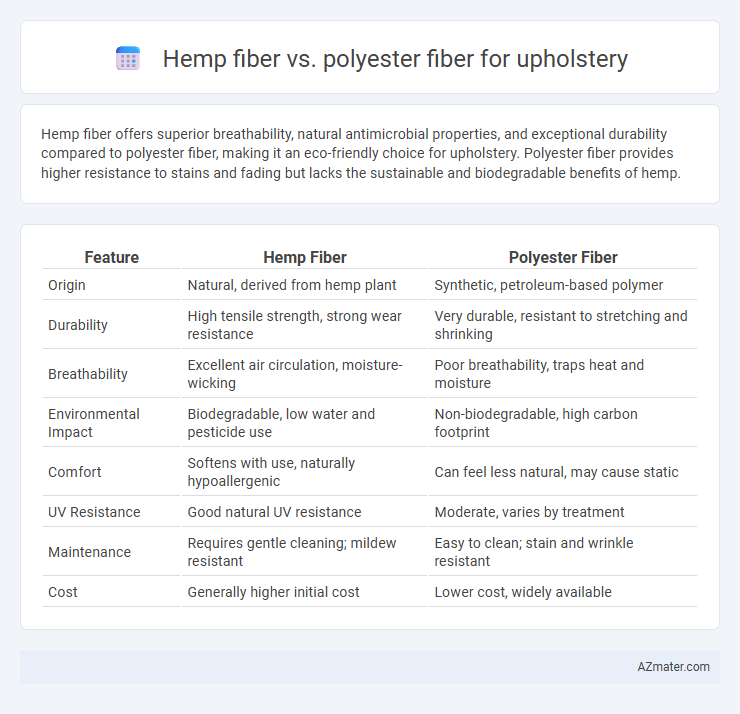Hemp fiber offers superior breathability, natural antimicrobial properties, and exceptional durability compared to polyester fiber, making it an eco-friendly choice for upholstery. Polyester fiber provides higher resistance to stains and fading but lacks the sustainable and biodegradable benefits of hemp.
Table of Comparison
| Feature | Hemp Fiber | Polyester Fiber |
|---|---|---|
| Origin | Natural, derived from hemp plant | Synthetic, petroleum-based polymer |
| Durability | High tensile strength, strong wear resistance | Very durable, resistant to stretching and shrinking |
| Breathability | Excellent air circulation, moisture-wicking | Poor breathability, traps heat and moisture |
| Environmental Impact | Biodegradable, low water and pesticide use | Non-biodegradable, high carbon footprint |
| Comfort | Softens with use, naturally hypoallergenic | Can feel less natural, may cause static |
| UV Resistance | Good natural UV resistance | Moderate, varies by treatment |
| Maintenance | Requires gentle cleaning; mildew resistant | Easy to clean; stain and wrinkle resistant |
| Cost | Generally higher initial cost | Lower cost, widely available |
Introduction to Hemp and Polyester Fibers
Hemp fiber is a natural, eco-friendly material derived from the stalks of the Cannabis sativa plant, prized for its durability, breathability, and resistance to wear, making it ideal for sustainable upholstery. Polyester fiber, a synthetic fabric made from petrochemicals, offers high strength, wrinkle resistance, and affordability but lacks the natural breathability and biodegradability of hemp. Comparing hemp and polyester fibers in upholstery highlights trade-offs between environmental impact, comfort, and performance based on their distinct material properties.
Environmental Impact of Hemp vs Polyester
Hemp fiber significantly reduces environmental impact compared to polyester fiber due to its biodegradable nature and minimal pesticide requirements during cultivation. Polyester, derived from petroleum, contributes to greenhouse gas emissions and microplastic pollution throughout its lifecycle. Choosing hemp fiber for upholstery supports sustainable practices by lowering carbon footprint and enhancing soil health.
Durability and Strength Comparison
Hemp fiber exhibits exceptional durability and tensile strength, making it highly resistant to wear and tear in upholstery applications. Polyester fiber offers strong durability with excellent resistance to stretching, shrinking, and abrasions, but tends to lack the natural toughness found in hemp. When comparing strength and longevity, hemp outperforms polyester by providing a more sustainable and resilient option for heavy-use upholstery.
Comfort and Texture Differences
Hemp fiber offers a natural, breathable texture that enhances comfort by allowing better airflow and moisture absorption compared to polyester fiber, which tends to feel smoother but less breathable due to its synthetic composition. The coarse yet soft feel of hemp upholstery provides a unique tactile experience that softens over time, while polyester maintains a consistent, often slick texture that can feel less inviting in warm conditions. Hemp's hypoallergenic properties promote a healthier indoor environment, contrasting with polyester's tendency to retain heat and static, affecting overall comfort.
Breathability and Moisture-Wicking Properties
Hemp fiber exhibits superior breathability compared to polyester fiber, allowing better air circulation that helps regulate indoor temperatures and prevent overheating. Its natural moisture-wicking properties draw sweat away from the skin, keeping upholstery dry and comfortable, whereas polyester tends to trap moisture, leading to potential discomfort and odor buildup. Choosing hemp fiber for upholstery enhances durability and promotes a healthier indoor environment by reducing mold and mildew growth associated with retained moisture.
Cleaning and Maintenance Requirements
Hemp fiber upholstery requires gentle cleaning with mild soaps and water, benefiting from its natural resistance to mold and mildew, which reduces the frequency of deep cleaning. Polyester fiber upholstery is more stain-resistant and easier to clean with most commercial upholstery cleaners, offering greater durability against wear and tear in high-traffic areas. Regular vacuuming extends the life of both materials, but polyester's synthetic composition generally demands less specialized maintenance than hemp fiber.
Cost and Market Availability
Hemp fiber offers a sustainable and eco-friendly alternative to polyester fiber for upholstery, typically commanding a higher price due to its natural cultivation process and limited large-scale production. Polyester fiber remains more cost-effective and widely available in the market because of its synthetic manufacturing, enabling mass production and consistent pricing. Market availability favors polyester with its established supply chains and broad retail presence, whereas hemp fiber is primarily found in niche and specialty markets emphasizing environmental benefits.
Allergenicity and Health Considerations
Hemp fiber is naturally hypoallergenic and resistant to dust mites and mold, making it an excellent choice for upholstery in homes with allergy sufferers or sensitive skin. Polyester fibers, often derived from synthetic polymers, may off-gas volatile organic compounds (VOCs) and trap allergens, potentially exacerbating respiratory issues or skin irritation. Choosing hemp fiber upholstery supports better indoor air quality and reduces exposure to synthetic chemicals linked to health concerns.
Aesthetic Versatility in Upholstery Design
Hemp fiber offers natural texture and rich earthy tones that enhance aesthetic versatility in upholstery design, allowing for both rustic and modern interiors. Polyester fiber provides a smooth, uniform finish with a wide range of vibrant colors and patterns, supporting diverse stylistic preferences. Combining hemp's organic appeal with polyester's colorfast properties creates upholstery solutions that balance natural elegance with design flexibility.
Conclusion: Which Fiber is Better for Upholstery?
Hemp fiber offers superior durability, breathability, and environmental sustainability, making it an excellent choice for eco-friendly upholstery projects. Polyester fiber provides cost-effectiveness, stain resistance, and ease of maintenance, appealing to budget-conscious applications requiring high durability. For upholstery, hemp is better suited for long-lasting, natural, and breathable furniture, while polyester excels in affordability and stain resistance, so the best fiber depends on specific usage priorities.

Infographic: Hemp fiber vs Polyester fiber for Upholstery
 azmater.com
azmater.com